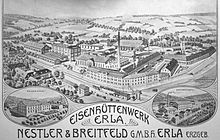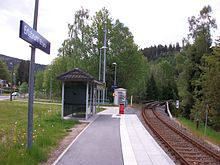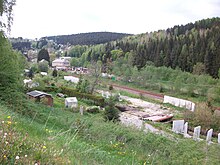Johanngeorgenstadt – Schwarzenberg railway line
| Johanngeorgenstadt – Schwarzenberg (Erzgeb) | |||||||||||||||||||||||||||||||||||||||||||||||||||||||||||||||||||||||||||||||||||||||||||||||||||||||||||||||||||||||||||||||||||||||||||||||||||||||||||||||||||||||||
|---|---|---|---|---|---|---|---|---|---|---|---|---|---|---|---|---|---|---|---|---|---|---|---|---|---|---|---|---|---|---|---|---|---|---|---|---|---|---|---|---|---|---|---|---|---|---|---|---|---|---|---|---|---|---|---|---|---|---|---|---|---|---|---|---|---|---|---|---|---|---|---|---|---|---|---|---|---|---|---|---|---|---|---|---|---|---|---|---|---|---|---|---|---|---|---|---|---|---|---|---|---|---|---|---|---|---|---|---|---|---|---|---|---|---|---|---|---|---|---|---|---|---|---|---|---|---|---|---|---|---|---|---|---|---|---|---|---|---|---|---|---|---|---|---|---|---|---|---|---|---|---|---|---|---|---|---|---|---|---|---|---|---|---|---|---|---|---|---|---|
|
Section of the route map of Saxony from 1902
| |||||||||||||||||||||||||||||||||||||||||||||||||||||||||||||||||||||||||||||||||||||||||||||||||||||||||||||||||||||||||||||||||||||||||||||||||||||||||||||||||||||||||
| Route number (DB) : | 6626; sä. JS | ||||||||||||||||||||||||||||||||||||||||||||||||||||||||||||||||||||||||||||||||||||||||||||||||||||||||||||||||||||||||||||||||||||||||||||||||||||||||||||||||||||||||
| Course book section (DB) : | 535 | ||||||||||||||||||||||||||||||||||||||||||||||||||||||||||||||||||||||||||||||||||||||||||||||||||||||||||||||||||||||||||||||||||||||||||||||||||||||||||||||||||||||||
| Route length: | 18.56 km | ||||||||||||||||||||||||||||||||||||||||||||||||||||||||||||||||||||||||||||||||||||||||||||||||||||||||||||||||||||||||||||||||||||||||||||||||||||||||||||||||||||||||
| Gauge : | 1435 mm ( standard gauge ) | ||||||||||||||||||||||||||||||||||||||||||||||||||||||||||||||||||||||||||||||||||||||||||||||||||||||||||||||||||||||||||||||||||||||||||||||||||||||||||||||||||||||||
| Route class : | CE | ||||||||||||||||||||||||||||||||||||||||||||||||||||||||||||||||||||||||||||||||||||||||||||||||||||||||||||||||||||||||||||||||||||||||||||||||||||||||||||||||||||||||
| Maximum slope : | 25 ‰ | ||||||||||||||||||||||||||||||||||||||||||||||||||||||||||||||||||||||||||||||||||||||||||||||||||||||||||||||||||||||||||||||||||||||||||||||||||||||||||||||||||||||||
| Minimum radius : | 150 m | ||||||||||||||||||||||||||||||||||||||||||||||||||||||||||||||||||||||||||||||||||||||||||||||||||||||||||||||||||||||||||||||||||||||||||||||||||||||||||||||||||||||||
|
|||||||||||||||||||||||||||||||||||||||||||||||||||||||||||||||||||||||||||||||||||||||||||||||||||||||||||||||||||||||||||||||||||||||||||||||||||||||||||||||||||||||||
The Johanngeorgenstadt – Schwarzenberg railway is a branch line in Saxony . It runs from Johanngeorgenstadt in the Schwarzwassertal to Schwarzenberg . The line has been part of the DB region network Erzgebirgsbahn since 2001 .
history
Prehistory and construction
When the Upper Ore Mountains Railway was built from Zwickau to Schwarzenberg (1855–1858), it was planned to extend it further across the border to Bohemia. In the State Treaty between Saxony and Austria of December 24, 1870, a connection between Karlsbad and Johanngeorgenstadt was specifically named for the first time. In it Austria assured " to grant the necessary licenses "
On November 13, 1872, the Austrian government granted the railway Pilsen – Priesen (–Komotau) (EPPK) the concession for a main railway line, which should branch off from the Pilsen – Dux connection in Mlatz and lead via Karlsbad to Johanngeorgenstadt . In December 1873, the Saxon state government applied for the construction of the Johanngeorgenstadt – Schwarzenberg line following this line at state expense. The Saxon state parliament approved the construction of the standard-gauge main line.
The difficult topographical conditions in Bohemia, however, required enormous financial resources for railway construction, which the EPPK could no longer raise after the financial crisis of 1873 . On May 6, 1880, the concession expired without the construction of the line had started. The project of the Saxon connection route Johanngeorgenstadt – Schwarzenberg has now been changed to the effect that a standard-gauge secondary railway has now been designed. The narrower curve radii permitted in this case enabled a more cost-effective route, which now managed to a large extent without expensive engineering structures. Construction of the line began in March 1881 and was opened on September 20, 1883.
business
On May 5, 1884, Saxony committed itself in a state treaty with Austria to convert the Johanngeorgenstadt station into a border station when the line to Karlsbad was built. The connection to Bohemia was finally realized as a second-class main line by the Karlsbad – Johanngeorgenstadt railway . The Saxon state was responsible for the reconstruction of the railway station in Johanngeorgenstadt and the construction of the short section of the state border - Johanngeorgenstadt in Saxony. On April 1, 1899, the Karlsbad – Johanngeorgenstadt railway was initially opened for limited freight traffic, and passenger trains started running on May 15, 1899. The management of the state border – Johanngeorgenstadt section was taken over by the State Railway Directorate of Pilsen on a lease basis.
On July 6, 1931, a flood destroyed 80 meters of track between Antonsthal and Breitenbrunn. In addition, there was damage to the retaining walls in the entire Schwarzwassertal. Traffic was idle until September 2, 1931.
After the Sudetenland was annexed to Germany in autumn 1938, there was initially still no through traffic across the former border. The 1939 summer timetable shows ten pairs of passenger trains between Johanngeorgenstadt and Schwarzenberg. They needed between 40 and 45 minutes for the entire route, which corresponds to a cruising speed of around 25 km / h. The route was later listed in the timetables as the route book route 171f Schwarzenberg – Neurohlau – Karlsbad / Chodau . In the 1944 annual timetable, four pairs of trains ran continuously between Schwarzenberg and Karlsbad, one of them to and from Marienbad .
At the end of the Second World War , the scheduled train traffic over the restored state border came to a standstill. For strategic reasons, however, the track connection remained passable. Except for a few business trips - e.g. for snow clearing operations - there was no longer any train service.
When uranium mining began in 1946 for the Soviet SAG Wismut in the Ore Mountains, the route quickly became extremely important for both the removal of the uranium ores that were extracted and for rush hour traffic to the newly established mine shafts in Johanngeorgenstadt. From 1948 the line was expanded for double-track operation. The route between Schwarzenberg and Erla and between Breitenbrunn and Erlabrunn was completely re-routed, which also included the construction of a new tunnel near Schwarzenberg and the Breitenbrunn freight station. Despite the expansion of the main line, however, it was not possible to widen all of the narrow curves. The permitted line speed was 40 km / h.
The Georgental branch was also newly built between Erlabrunn and Johanngeorgenstadt. The connecting railway branching off here led to a loading facility for uranium ore for shipment to the Soviet Union. The new line was completed in 1950. On October 5, 1952, the double-track line was elevated to the main line .
Just a few years later, mining in Johanngeorgenstadt was stopped again and traffic performance fell back to normal. On July 1, 1964, the line was downgraded again to a branch line. The second track between Erla and Johanngeorgenstadt was dismantled in the 1970s.


In the 1980/81 winter timetable, a total of 14 pairs of passenger trains ran, most of which were connected to and from Zwickau (Sachs) Hbf. The travel time between Johanngeorgenstadt and Schwarzenberg was around 35 minutes, and from and to Zwickau around two hours.
The route gained new perspectives with the political upheavals in the GDR and Czechoslovakia in 1989 and 1990. After decades of separation, both sides wanted to renew the old traditional traffic connections across the border. On April 17, 1992, a passenger train passed the state border at Johanngeorgenstadt for the first time since 1945. With the timetable change in June 1992, regular cross-border travel and goods traffic was resumed. Contrary to the original plans, however, direct trains on the Zwickau – Karlsbad route did not run through.
In 1999 the remaining freight traffic was stopped. Most recently, mainly raw wood was transported, which was loaded in Johanngeorgenstadt.
From 2000, extensive renovation work took place on the route with the aim of increasing travel speeds. The Erla – Schwarzenberg section, which had previously been operated on two tracks, was also reduced to a single track.
In 2012 timetable operate regional trains of Erzgebirgsbahn in Einstundentakt , where all trains to and from Zwickau (Sachs) Hbf be bound. Individual trains run on the weekend in cooperation with the Czech railway company České dráhy (ČD) on the Zwickau – Karlsbad route. Scheduled freight traffic does not take place.
Route description
course
The old, original route of the Johanngeorgenstadt – Schwarzenberg line ran along its entire length in the valley floor of the Schwarzwassertal, with the eponymous river being bridged a total of eleven times. The only tunnel on the route was under the Schlossberg in Schwarzenberg. In the course of the partial re-routing between 1948 and 1950, the line in the Schwarzenberg urban area was given a new route on the orographically right valley flank, including a new double-track tunnel. Their nominal start of the compound Johanngeorgenstadt-Schwarzenberg today at kilometer -0.721 directly to the state border Czech Republic-Germany.
Operating points
Johanngeorgenstadt ⊙
The Johanngeorgenstadt station was initially only designed as a terminus for the secondary line. In the course of the construction of the Karlsbad – Johanngeorgenstadt line (1899) it was expanded to become a border station . It got its final size in the course of the double-track line expansion from 1948 to 1950. A new loading track system was also built east of the old station, which was integrated via a double crossing switch directly at the state border (at the connection to Eisenwerk Wittigsthal).
The station, which was badly damaged by a fire, was comprehensively repaired after 2000, which also included the construction of new platforms. The freight transport facilities that were last used for timber handling have largely been dismantled today.
Erlabrunn (Erzgeb) ⊙
The Erlabrunn stop was opened on September 20, 1883. The station had the following names:
- until 1901: Erlabrunn
- until 1911: Erlabrunn i Erzgeb
- since 1911: Erlabrunn (Erzgeb)
The station was elevated to a station in 1905 and downgraded to a stop in 1933. At the time of uranium mining, it was again a train station between 1949 and 1951 and has been a stop since then. The breakpoint is located east of the village between Schwarzwasser and "Schwarzenberger Straße".
Breitenbrunn (Erzgeb) Gbf ⊙
The freight yard Breitenbrunn (Erzgeb) Gbf was established in 1950 in the course of the re-routing of the section between Erlabrunn and Breitenbrunn by uranium mining. It was shut down in February 1996. The freight yard was located between the places Erlabrunn and Breitenbrunn. Its access road is still known today as Am Güterbahnhof .
Breitenbrunn (Erzgeb) ⊙
The Breitenhof stop was opened on September 20, 1883. On May 1, 1905, it was dedicated to the station. After the incorporation of Breitenhof to Breitenbrunn in July 1935, the station was renamed Breitenbrunn (Erzgeb) on October 6, 1935 . Breitenbrunn (Erzgeb) has been a stopping point since October 1st, 1993.
Antonstal ⊙
Today, Antonsthal station is the only station on the line where oncoming trains can cross.
Allow ⊙
The Erla stop was opened on September 20, 1883. Between 1905 and 2000 it was dedicated as a train station. The stop is between Schwarzwasser and Karlsbader Straße.
Schwarzenberg (Erzgeb) Hp ⊙
Schwarzenberg Haltpunkt was opened on September 20, 1883. In the following years it was named as follows:
- until 1911: Schwarzenberg halt
- until 1933: Schwarzenberg Hp
- since 1935: Schwarzenberg (Erzgeb) Hp
In the course of the re-routing of the railway line in the area of Schwarzenberg's old town, the stop was relocated by a few meters in 1950. It can be reached via Karlsbader Straße via a tunnel-like roofed staircase.
Schwarzenberg (Erzgeb) ⊙
Schwarzenberg (Erzgeb) station was opened in 1854 as the end point of the Upper Erzgebirge Railway from Zwickau. In the course of the construction of the Johanngeorgenstadt – Schwarzenberg (1884) and Buchholz – Schwarzenberg (1889) routes , it was significantly expanded for the first time. It reached its final size in the course of the double-track expansion of the entire connection from Zwickau to Johanngeorgenstadt in the early 1950s. During this time, the small locomotive deployment station was also elevated to a depot .
Vehicle use
The Royal Saxon State Railways purchased two class IV TS locomotives named JOHANNGEORGENSTADT and ERLA as well as three two-axle passenger cars as initial equipment .
After the line had been upgraded to the main line, the class 84 tank locomotives, originally built for the Eastern Ore Mountains Müglitztalbahn, were stationed in Schwarzenberg in 1949 . A high tendency to derail in tight bends as well as insufficient stocks for the heavy freight train service ended the service between 1953 and 1956. The locomotives of the Prussian class 58.10-21 , which remained in use until they were replaced by modern diesel locomotives, proved to be better .
The conversion to diesel traction began in the early 1970s. Passenger and freight trains were now transported with the class 110 and 118 locomotives . The heavy Soviet large diesel locomotives were not approved because of the narrow track curves and excessive axle loads.
From 1994 onwards, Deutsche Bahn AG used modern regional railcars of the 628.4 series on most circuits . Locomotive-hauled trains of the 219 series only operated when the railcars failed or when there was greater demand in winter sports traffic . Since 2000, all travel traffic has been handled with the newly acquired class 642 multiple units.
literature
- Reiner Preuß: 100 years Johanngeorgenstadt - Schwarzenberg (Erzgeb.). In: Modelleisenbahner Heft 9, 1983, pp. 3–6.
- Erich Preuß , Reiner Preuß : Saxon State Railways . transpress Verlagsgesellschaft, Berlin 1991, ISBN 3-344-70700-0 .
- Falk Thomas: The Obererzgebirgische Eisenbahn Schwarzenberg - Zwickau and its continuation through the Schwarzwassertal to Johanngeorgenstadt. Association of Saxon Railway Friends V., Schwarzenberg 2008 ( Saxon Railway History Book 8, ZDB -ID 2286230-4 ).
- Royal General Directorate of the Saxon State Railways (Ed.): Saxon Branch Railways (1886). Reprint: European University Press, Bremen, ISBN 978-3-86195-287-9
- Günter Meyer : Zwickau - Johanngeorgenstadt . A journey through time with Günter Meyer. Ed .: Thomas Frister. EK, Freiburg 2016, ISBN 978-3-8446-6218-4 (based on a manuscript by Meyers from 1983).
Web links
Individual evidence
- ↑ Route data on www.sachsenschiene.de
- ↑ STREDA - DB AG route data file, status 2003
- ^ State treaty between Saxony and Austria of December 24, 1870
- ^ Certificate of concession for the Locomotiv-Eisenbahn Pilsen-Klattau-Eisenstein and Mlatz-Johanngeorgenstadt
- ^ Announcement by the Minister of Commerce of May 6, 1880
- ↑ Summer timetable 1939 - valid from May 15 to October 7, 1939
- ↑ Annual timetable 1944 - valid from July 3, 1944 until further notice
- ^ Club M 131.1 (ed.): Krušnohorský Semmering Karlovy Vary - Johanngeorgenstadt Erzgebirgische Semmering , self-published by Sokolov, 1999
- ^ Course book of the Deutsche Reichsbahn, valid from September 28, 1980 to May 30, 1981
- ↑ 2012 annual timetable of the Erzgebirgsbahn - valid from December 11, 2012
- ↑ Saxon branch lines (1886), p. 19


















